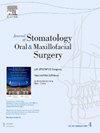通过铁纳米粒子涂层优化钛植入物的稳定性和抗感染能力:临床前研究。
IF 1.8
3区 医学
Q2 DENTISTRY, ORAL SURGERY & MEDICINE
Journal of Stomatology Oral and Maxillofacial Surgery
Pub Date : 2024-11-15
DOI:10.1016/j.jormas.2024.102155
引用次数: 0
摘要
背景:获得充分的骨结合和减少感染是种植学的首要问题,尤其是在牙科和整形外科领域。钛种植体具有生物相容性和机械强度,但种植体周围感染和骨整合不足等问题可能会削弱其功效。在钛植入物上涂覆纳米铁粒子(FeNp)已成为改善骨结合和抗菌特性的一种可行方法。铁纳米粒子具有独特的磁场反应能力,能产生活性氧(ROS),因此有可能提高植入效果:评估 FeNp 涂层钛种植体对骨结合、机械稳定性、成骨和抗菌效果的影响,以预防与种植体相关的常见感染--金黄色葡萄球菌和大肠杆菌:对动物模型进行体内研究,通过共振频率分析(RFA)和植入后 6 周和 12 周的移除扭矩测量来评估植入体的稳定性。组织病理学评估分析了植入物周围的骨形成和血管化情况。此外,还采用了体外实验来评估磁化 FeNp 对金黄色葡萄球菌和大肠杆菌的抗菌效果:6 周时,对照组(A 组)和试验组(B 组)之间在(RFA)或移除扭矩方面未发现实质性变化。但在 12 周时,B 组的 RFA 评分(75.02 ± 5.11)明显高于 A 组(67.41 ± 9.85),表明种植体的稳定性有所提高(p < 0.05)。与 A 组(46.10 ± 9.25)相比,B 组在 12 周时的移除扭矩值(76.30 ± 14.20)也明显更高,这表明机械整合性得到了增强(p < 0.01)。此外,体外抗菌测试表明,FeNp 涂层能有效抑制金黄色葡萄球菌和大肠杆菌的生长,进一步证明了其抗菌效果:FeNp涂层植入物具有双重优势:改善骨结合和抗菌防御。研究结果表明,FeNp 涂层可大大延长种植体的使用寿命,降低感染的可能性,为临床应用提供了一种潜在的方法,特别是对种植体失败风险较高的患者。后续研究应集中于加强氮化铁涂层在临床环境中的应用,并进一步研究其长期生物相容性和有效性。本文章由计算机程序翻译,如有差异,请以英文原文为准。
Optimising titanium implant stability and infection resistance through iron nanoparticle coatings: A preclinical investigation
Background
Attaining adequate osseointegration and mitigating infections are paramount issues in implantology, especially within dental and orthopaedic domains. Titanium implants have been utilised for their biocompatibility and mechanical strength; yet, problems such as peri‑implant infections and inadequate bone integration may undermine their efficacy. Coating titanium implants with iron nanoparticles (FeNp) has surfaced as a promising approach to improve osseointegration and antibacterial characteristics. FeNp's distinctive capacity to react to magnetic fields and produce reactive oxygen species (ROS) has the potential to enhance implant results.
Objective
To assess the influence of FeNp-coated titanium implants on osseointegration, mechanical stability, osteogenesis, and antibacterial effectiveness against prevalent implant-associated infections, Staphylococcus aureus and Escherichia coli.
Materials and methods
In vivo investigations were performed on animal models to evaluate implant stability by resonance frequency analysis (RFA) and removal torque measurements at 6 and 12 weeks post-implantation. Histopathological assessment was conducted to analyze the osseous formation and vascularization surrounding the implants. Furthermore, in vitro experiments were employed to assess the antibacterial efficacy of magnetized FeNp against S. aureus and E. coli.
Results
At 6 weeks, no substantial change was detected in (RFA) or removal torque between the control group (GROUP A) and the test group (GROUP B). However, by 12 weeks, GROUP B demonstrated significantly higher RFA scores (75.02 ± 5.11) compared to GROUP A (67.41 ± 9.85), indicating improved implant stability (p < 0.05). Removal torque values were also significantly higher in GROUP B at 12 weeks (76.30 ± 14.20) compared to GROUP A (46.10 ± 9.25), suggesting enhanced mechanical integration (p < 0.01). Histopathological analysis revealed greater new bone formation, increased osteoblast activity, and improved vascularization around FeNp-coated implants in GROUP B. Additionally, in vitro antibacterial testing demonstrated that FeNp coatings effectively inhibited the growth of Staphylococcus aureus and E. coli, providing further evidence of its antimicrobial effect
Conclusion
FeNp-coated implants have dual advantages: improved osseointegration and antibacterial defence. The findings indicate that FeNp coatings might substantially enhance implant longevity and diminish the likelihood of infection, offering a potential approach for clinical applications, especially for patients at elevated risk of implant failure. Subsequent research should concentrate on enhancing the application of FeNp coatings in clinical environments and further examining their long-term biocompatibility and effectiveness.
求助全文
通过发布文献求助,成功后即可免费获取论文全文。
去求助
来源期刊

Journal of Stomatology Oral and Maxillofacial Surgery
Surgery, Dentistry, Oral Surgery and Medicine, Otorhinolaryngology and Facial Plastic Surgery
CiteScore
2.30
自引率
9.10%
发文量
0
审稿时长
23 days
 求助内容:
求助内容: 应助结果提醒方式:
应助结果提醒方式:


